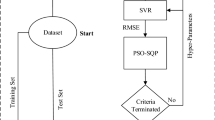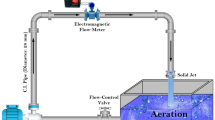Abstract
Filtration combustion is a type of combustion in which exothermic reactions occur within a porous matrix. In recent years, some researches were performed on the use of noncatalytic partial oxidation method for hydrogen production in reactors based on filtration combustion. In this paper, a new technique is presented for estimation of some important characteristics of filtration combustion process. Hydrogen production, peak combustion temperature, and wave velocity are three main variables which are estimated by suggested forecasting engine. The parameters which have direct effect on above-mentioned variables are: equivalence ratio (\(\varphi\)), reactant inlet velocity (V), bed porosity (\(\varepsilon\)), heat conductivity (K), and the heating value of fuel. The estimation process is realized though two steps: feature selection and regression. At first step, the features are ranked according to their importance degree. The well-known Gram–Schmidt orthogonalization feature selection is employed for ranking of effective input parameters. In the second step, extreme learning machine (ELM) and support vector machine (SVM) are utilized as regression cores of forecasting engine. For each feature subset, the estimation accuracy is calculated in order to find the most important feature subset. The obtained results show that the ELM yields the better performance for the prediction of peak temperature and wave velocity as compared to SVM.













Similar content being viewed by others
Explore related subjects
Discover the latest articles, news and stories from top researchers in related subjects.References
Dhamrat RS, Ellzey JL (2006) Numerical and experimental study of the conversion of methane to hydrogen in a porous media reactor. Combust Flame 144:698–709. doi:10.1016/j.combustflame.2005.08.038
Smith CH, Pineda DI, Zak CD, Ellzey JL (2013) Conversion of jet fuel and butanol to syngas by filtration combustion. Int J Hydrogen Energy 38:879–889. doi:10.1016/j.ijhydene.2012.10.102
Mujeebu MA, Abdullah MZ, Bakar MZA, Mohamad AA, Muhad RMN, Abdullah MK (2009) Combustion in porous media and its applications—1A comprehensive survey. J Environ Manag 90:2287–2312. doi:10.1016/j.jenvman.2008.10.009
Bingue JP, Saveliev AV, Fridman AA, Kennedy LA (2002) Hydrogen production in ultra-rich filtration combustion of methane and hydrogen sulfide. Int J Hydrogen Energy 27:643–649. doi:10.1016/S0360-3199(01)00174-4
Dixon MJ, Schoegl I, Hull CB, Ellzey JL (2008) Experimental and numerical conversion of liquid heptane to syngas through combustion in porous media. Combust Flame 154:217–231. doi:10.1016/j.combustflame.2008.02.004
Smith CH, Leahey DM, Miller LE, Ellzey JL (2011) Conversion of wet ethanol to syngas via filtration combustion: an experimental and computational investigation. Proc Combust Inst 33:3317–3324. doi:10.1016/j.proci.2010.06.006
Gentillon P, Toledo M (2013) Hydrogen and syngas production from propane and polyethylene. Int J Hydrogen Energy 38:9223–9228. doi:10.1016/j.ijhydene.2013.05.058
Pastore A, Mastorakos E (2011) Syngas production from liquid fuels in a non-catalytic porous burner. Fuel 90:64–76. doi:10.1016/j.fuel.2010.08.003
Gao HB, Qu ZG, Feng XB, Tao WQ (2014) Methane/air premixed combustion in a two-layer porous burner with different foam materials. Fuel 115:154–161. doi:10.1016/j.fuel.2013.06.023
Caro S, Torres D, Toledo M (2015) Syngas production from residual biomass of forestry and cereal plantations using hybrid filtration combustion. Int J Hydrogen Energy 40:2568–2577. doi:10.1016/j.ijhydene.2014.12.102
Toledo M, Vergara E, Saveliev AV (2011) Syngas production in hybrid filtration combustion. Int J Hydrogen Energy 36:3907–3912. doi:10.1016/j.ijhydene.2010.11.060
Araus K, Reyes F, Toledo M (2014) Syngas production from wood pellet using filtration combustion of lean natural gas-air mixtures. Int J Hydrogen Energy 39:7819–7825. doi:10.1016/j.ijhydene.2014.03.140
Toledo M, Gracia F, Caro S, Gómez J, Jovicic V (2016) Hydrocarbons conversion to syngas in inert porous media combustion. Int J Hydrogen Energy 41:5857–5864. doi:10.1016/j.ijhydene.2016.02.065
Ripoll N, Silvestre C, Paredes E, Toledo M (2016) Hydrogen production from algae biomass in rich natural gas-air filtration combustion. Int J Hydrogen Energy. doi:10.1016/j.ijhydene.2016.03.082 (in press)
Guoneng LI, Hao ZHOU, Xinping QIAN, Kefa CEN (2008) Determination of hydrogen production from rich filtration combustion with detailed kinetics based CFD method. Chin J Chem Eng 16(2):292–298. doi:10.1016/S1004-9541(08)60077-4
Smith CH, Pineda DI, Ellzey JL (2013) Syngas production from burner-stabilized methane/air flames: the effect of preheated reactants. Combust Flame 160:557–564. doi:10.1016/j.combustflame.2012.10.022
Araya R, Araus K, Utria K, Toledo M (2014) Optimization of hydrogen production by filtration combustion of natural gas by water addition. Int J Hydrogen Energy 39:7338–7345. doi:10.1016/j.ijhydene.2014.02.113
Mishra VK, Mishra SC, Basu DN (2015) combined mode conduction and radiation heat transfer in a porous medium and estimation of the optical properties of the porous matrix. Numer Heat Transf Part A 67:1119–1135. doi:10.1080/10407782.2014.955358
Bubnovich V, Henríquez L, Gnesdilov N (2007) numerical study of the effect of the diameter of alumina balls on flame stabilization in a porous-medium burner. Numer Heat Transf Part A 52:275–295. doi:10.1080/00397910601149942
Janakiraman VM, Nguyen X, Sterniak J, Assanis D (2015) Identification of the dynamic operating envelope of hcci engines using class imbalance learning. IEEE Trans Neural Netw Learn Syst 26:98–112. doi:10.1109/TNNLS.2014.2311466
Bamiji Z, Adewole Olatunde A, Abidakun AA Asere (2013) Artificial neural network prediction of exhaust emissions and flame temperature in LPG (liquefied petroleum gas) fueled low swirl burner. Energy 61:606–611. doi:10.1016/j.energy.2013.08.027
Bahadori A, Baghban A, Bahadori M, Lee M, Ahmad Z, Zare M, Abdollahi E (2016) Computational intelligent strategies to predict energy conservation benefits in excess air controlled gas-fired systems. Appl Therm Eng. doi:10.1016/j.applthermaleng.2016.04.005 (in press)
Huang G-b, Zhu Q-y, Siew C-k (2004) Extreme learning machine: a new learning scheme of feed forward neural networks. Proc Int Jt Conf Neural Netw 2:985–990. doi:10.1109/IJCNN.2004.1380068
Mladenović I, Marković D, Milovančević M, Nikolić M (2016) Extreme learning approach with wavelet transform function for forecasting wind turbine wake effect to improve wind farm efficiency. Adv Eng Softw 96:91–95. doi:10.1016/j.advengsoft.2016.02.011
Shamshirband S, Mohammadi K, Yee PL, Petković D, Mostafaeipour A (2015) A comparative evaluation for identifying the suitability of extreme learning machine to predict horizontal global solar radiation. Renew Sustain Energy Rev 52:1031–1042. doi:10.1016/j.rser.2015.07.173
Ding L, Xin J, Wang G (2016) An efficient query processing optimization based on ELM in the cloud. Neural Comput Appl 27:35–44. doi:10.1007/s00521-013-1543-3
Shamshirband S, Mohammadi K, Chen H-L, Samy GN, Petković D, Ma C (2015) Daily global solar radiation prediction from air temperatures using kernel extreme learning machine: a case study for Iran. J Atmos Solar Terr Phys 134:109–117. doi:10.1016/j.jastp.2015.09.014
Cortes C, Vapnik V (1995) Support-vector networks. Mach Learn 20:273–297. doi:10.1023/A:1022627411411
Elish OK, Elish MO (2008) Predicting defect-prone software modules using support vector machines. J Syst Softw 81:649–660. doi:10.1016/j.jss.2007.07.040
Petković D, Shamshirband S, Saboohi H, Ang TF, Anuar NB, Rahman ZA, Pavlović NT (2014) Evaluation of modulation transfer function of optical lens system by support vector regression methodologies–a comparative study. Infrared Phys Technol 65:94–102. doi:10.1016/j.infrared.2014.04.005
Shamshirband S, Petković D, Javidnia H, Gani A (2015) Sensor data fusion by support vector regression methodology–a comparative study. IEEE Sens J 15(2):850–854. doi:10.1109/JSEN.2014.2356501
Piri J, Shamshirband S, Petković D, Tong CW, ur Rehman MH (2015) Prediction of the solar radiation on the Earth using support vector regression technique. Infrared Phys Technol 68:179–185. doi:10.1016/j.infrared.2014.12.006
Mohammadi K, Shamshirband S, Tong CW, Arif M, Petković D, Sudheer Ch (2015) A new hybrid support vector machine–wavelet transform approach for estimation of horizontal global solar radiation. Energy Convers Manag 92:162–171. doi:10.1016/j.enconman.2014.12.050
Amini H, Gholami R, Monjezi M, Torabi SR, Zadhesh JZ (2012) Evaluation of flyrock phenomenon due to blasting operation by support vector machine. Neural Comput Appl 21:2077–2085. doi:10.1007/s00521-011-0631-5
Kisi O, Shiri J, Karimi S, Shamshirband S, Motamedi S, Petković D, Hashim R (2015) A survey of water level fluctuation predicting in Urmia Lake using support vector machine with firefly algorithm. Appl Math Comput 270:731–743. doi:10.1016/j.amc.2015.08.085
Shenify M, Danesh AS, Gocić M, Taher RS, Wahab AWA, Gani A, Shamshirband S, Petković D (2016) Precipitation estimation using support vector machine with discrete wavelet transform. Water Resour Manag 30(2):641–652. doi:10.1007/s11269-015-1182-9
Guyon I (2008) Practical feature selection from correlation to causality. In: Mining massive data sets for security. Amsterdam: IOS Press; 2008; 19: 27-43, doi:10.3233/978-1-58603-898-4-27
Stoppiglia H, Dreyfus G, Dubois R, Oussar Y (2003) Ranking a random feature for variable and feature selection. J Mach Learn Res 3:1399–1414
Huang G-B, Zhu Q-Y, Siew C-K (2006) Extreme learning machine: theory and applications. Neurocomputing 70:489–501. doi:10.1016/j.neucom.2005.12.126
Huang G-B, Chen L, Siew C-K (2006) Universal Approximation using incremental constructive feedforward networks with random hidden nodes. IEEE Trans Neural Netw 17(4):879–892. doi:10.1109/TNN.2006.875977
Huang G-B, Chen L (2007) Convex incremental extreme learning machine. Neurocomputing 70:3056–3062. doi:10.1016/j.neucom.2007.02.009
Wang L (2005) Support vector machines: theory and applications. Springer, Berlin, p 177. doi:10.1007/b95439
Abdoos A, Hemmati M, Abdoos AA (2015) Short term load forecasting using a hybrid intelligent method. Knowl Based Syst 76:139–147. doi:10.1016/j.knosys.2014.12.008
Author information
Authors and Affiliations
Corresponding author
Rights and permissions
About this article
Cite this article
Shabanian, S.R., Abdoos, A.A. A hybrid soft computing approach based on feature selection for estimation of filtration combustion characteristics. Neural Comput & Applic 30, 3749–3757 (2018). https://doi.org/10.1007/s00521-017-2956-1
Received:
Accepted:
Published:
Issue Date:
DOI: https://doi.org/10.1007/s00521-017-2956-1




